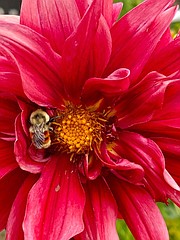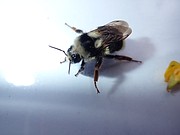MASTER GARDENER: Bumble bee basics
Bumble bees are an important pollinator of wild flowering plants, as well as garden and agricultural crops. Bumbles will fly in low-light levels, in cooler temperatures, and perform “buzz pollination” — a pollination technique where the bee grabs the flower in its mandible and vibrates its wing muscles to release pollen from the flower. Many home-garden crops, like tomatoes and peppers, benefit from buzz pollination.
However, the bees were a bit late in arriving this year due to the cold, wet spring. This caused a delay in the emergence of mated bees from their overwintering sites, and in turn, delayed their offspring from foraging during the spring to summer transition.
This seemed to be the case all across gardens in the Pacific Northwest. The mismatched timing between the bee’s emergence and the flowers that provide resources for them, caught the attention of many scientists and citizen-scientists around our region.
Changes in weather aren’t the only threat to these fuzzy friends in our gardens. Habitat loss, pesticide use, introduced pathogens, and overgrazing all play a role. In fact, nearly fifty species of bumble bees are undergoing dramatic population declines as monitored by the Xerces Society for Invertebrate Conservation.
The great news is that we can actively help. Protecting and creating habitat is an easy and essential step. We know our gardens in town may already hold valuable resources for bumble bees. Creating and maintaining habitat in more rural areas is the next step for landowners, agencies, and municipalities to focus on.
Another step outdoor enthusiasts can take is to help scientists understand where bumble bees live and what they need in more remote areas. Scientists can’t reach all the places where we need to learn about these pollinators.
That’s where we can help once again. We can continue to monitor wild places with the Xerces Society and their Pacific Northwest Bumble bee Atlas Project. This citizen-science project trains volunteers to monitor habitat, safely capture bumble bees to gather photographs and data, submit observations, and continue learning.
Many Idaho Master Gardeners, including myself, have been participating in this ongoing project around our region. It is a great way to explore beautiful places while spending time outdoors. Providing useful data and photographs, without harming bees or habitat allows me to slow down, discover these insects, and know that I am making a difference on a larger scale.
This year, Idaho Master Gardeners expanded our efforts to offer the Atlas project to 4-H youth programs and summer camps. Adults and youth are collecting species and providing data about the area around our office extending along the Spokane River.
We have been particularly keen on finding species that are declining in our region, such as the Western bumble bee, Morrison’s bumble bee, and the Suckley cuckoo bumble bee. We invite you to learn with us or join in the PNW bumble bee Atlas Project with your friends or family.
You can also help support bumble bees in your own garden by adding native plants to your garden that bloom during each phase of our growing season; leaving a brush pile or create one for nesting sites; and reducing pesticide applications (synthetic and organic).
We encourage you to learn about alternative methods of insect control. If you have any questions, please reach out to us — we are here for you!
Kara Carleton is the Program Coordinator for the Idaho Master Gardener program and a Certified Idaho Master Gardener. The University of Idaho Extension, Kootenai County Idaho Master Gardener program is located in the UI Research Park, 958 S. Lochsa St., in Post Falls. Learn more about us at https://www.uidaho.edu/extension/county/kootenai/garden or on Facebook. Visit us in person, email us at kootenaimg@uidaho.edu, or call us at (208) 292-2525. IMG services are free to the public.







